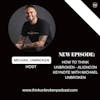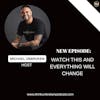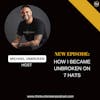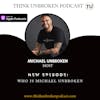Rewiring Your Nervous System to Overcome Childhood Trauma | with Lindsay Mitchell
In this transformative episode, Lindsay Mitchell, one of the last Unbroken Conference's guest speakers, shares her empowering story of overcoming trauma and chronic illness to help others thrive. She explains... See show notes at: https://www.thinkunbrokenpodcast.com/rewiring-your-nervous-system-to-overcome-childhood-trauma-with-lindsay-mitchell/#show-notes
In this transformative episode, Lindsay Mitchell, one of the last Unbroken Conference's guest speakers, shares her empowering story of overcoming trauma and chronic illness to help others thrive. She explains the science behind nervous system regulation and neuroplasticity – how our brains can rewire to communicate safety instead of stress. Listen as Lindsay guides you through exercises to tap into your body's natural resilience. Learn her research-backed tools to decrease anxiety and inflammation so you can fight infections, process trauma, and connect with motivation and joy. Whether you have an autoimmune condition, depression, or feel burned out, Lindsay provides a clear framework to understand your nervous system's survival responses. Follow along with bilateral stimulation tapping and box breathing to change your inner state. Discover daily habits to release feel-good hormones like oxytocin and dopamine. Lindsay offers compassionate wisdom and practical techniques so you can communicate a new signal of ease to your mind and body. Tune in to rewire your nervous system, unlock your natural resilience, and start living a life you love.
************* LINKS & RESOURCES *************
Learn how to heal and overcome childhood trauma, narcissistic abuse, ptsd, cptsd, higher ACE scores, anxiety, depression, and mental health issues and illness. Learn tools that therapists, trauma coaches, mindset leaders, neuroscientists, and researchers use to help people heal and recover from mental health problems. Discover real and practical advice and guidance for how to understand and overcome childhood trauma, abuse, and narc abuse mental trauma. Heal your body and mind, stop limiting beliefs, end self-sabotage, and become the HERO of your own story.
Join our FREE COMMUNITY as a member of the Unbroken Nation: https://www.thinkunbrokenacademy.com/share/AEGok414shubQSzq?utm_source=manual
Download the first three chapters of the Award-Winning Book Think Unbroken: Understanding and Overcoming Childhood Trauma: https://book.thinkunbroken.com/
Join the Think Unbroken Trauma Transformation Course: https://coaching.thinkunbroken.com/
@Michael Unbroken: https://www.instagram.com/michaelunbroken/
Follow us on TikTok: https://www.tiktok.com/@michaelunbroken
Learn more at https://www.thinkunbrokenpodcast.com
Learn more about Lindsay Mitchell at: https://vital-side.com/
Support this podcast at — https://redcircle.com/think-unbroken-with-michael-unbroken-childhood-trauma-cptsd-and/exclusive-content
Advertising Inquiries: https://redcircle.com/brands
Privacy & Opt-Out: https://redcircle.com/privacy
Support the Podcast: Become a listed sponsor!
Follow me on Instagram @MichaelUnbroken
Learn more about coaching at https://coaching.thinkunbroken.com
Get your FREE copy of my #1 Best-Selling Book Think Unbroken: https://book.thinkunbroken.com/
Thank you everyone here who is watching. It's amazing to be here with so many people who are being so vulnerable and vulnerability is our strength as humans. And I just, I well up every time, you know, I hear Michael speak or I see someone say, yes, I got it. And just being vulnerable with themselves. So I truly commend you for taking the time to be here and to learn more about yourself. Y'all, this process is not easy. This is really hard work, but I can tell you straight up that this is the work that has saved my life and all the lives of these speakers here, right? Doing the work is hard, but we are here to do the work so that we can change the outcome of our experience of life. And that's what unites us. We want to optimize our experience of life. So y'all, I'll tell you a little bit more about me. I'm here in Austin, Texas, if you couldn't tell with the y'all, I am the founder of a company called Vital Side, and I work with people who have chronic illnesses and chronic stress. So what I do is give them resources to access their natural resilience that exists within their nervous systems. So this is something I am so passionate about. And after 13 years of studying biology, neuroscience, and working as a physician assistant in internal medicine, I truly know that the nervous system, this piece of healing is my life's work. When we are able to tap into our natural resilience that exists within the nervous system, we're able to create a more dynamic way of living so that we can begin to feel good in our lives. And that's not easy to do when you have experienced chronic trauma in your life, but it's necessary to get the most out of life. I wanna tell you a little bit about my story, because I wanna share in this vulnerability that we're all sharing in. So in my early twenties, I was diagnosed with chronic Lyme disease, and this diagnosis was made after about six months of experiencing these daily symptoms, migraines, joint pain and swelling, anxiety, food sensitivities, and chronic fatigue. So this perfect storm of symptoms came after a tick bite that I got in the redwood forest. And the next year and a half, my whole life revolved around surviving. So for months I was bedridden with ailments, my family moved next door to me, my husband took an at-home job, and my life became a series of appointments that simply sustained me until the next day, and then I had to do the whole thing over again. So at one point, my joints were so painful that I couldn't lift my arm over my head to wash my hair. And throughout this process of healing, the diet change, the detox, the treatment, I seemed to get worse, or at least I really felt worse. Anxiety, which I had never really experienced so directly before, went through the roof and I'd have these bouts of hallucinations, which brought me to my knees every time to the point where I wanted to end it all, y'all. I thought that ending my life would mean ending these constant demons of this chronic illness that I couldn't seem to shake. And I remember one night in particular, it was three in the morning, I was lying on the ground in my spare bedroom and I was having a hallucination, and as a result, I was pulling my hair, trying to make them stop. And then it was like all the anxiety that I had in my body rolled up into one moment, tensing up every muscle, squeezing every tear out of me, beating my heart out of my chest, and then silence, it was like my body took a deep breath, and for about one minute, I felt this full physical reprieve, a wave of calm swept over me and through my body. And this was a glimpse into what life could be and all that was waiting for me. So after about a minute, I started to become more aware of my physical symptoms, they started to return, but that was the moment I knew, this healing is not just about my physical body, this healing goes so much deeper, and that was the moment I decided to go deeper.
Now, like many of you, I come from a long line of trauma. I grew up with a father who was diagnosed with schizophrenia and bipolar, and my mom caught him several times catatonic on the floor when I was just a kid. And she really wanted to make the relationship work and she really didn't wanna break up our family, but he only got worse, and he'd experienced these manic episodes where he'd be up all night and he'd sleep all day. And then his illness turned malicious with a hyper focus on me, and it started out pretty mild. He began blaming me for things that went missing in his office, so pieces of paper or parts of his project. And I would quickly be punished. So I'd have to clean out his 50 gallon fish tank until 12 in the morning or maybe I was locked in my room for a few hours and then it got worse. I was tied up in a chair for hours on end, told that I was gonna get kidnapped and no one would save me or believe me if I told the truth. And at one point, he burned all my clothes, he'd come into my room in the night and pour oil all over me, or worse, dragged me outta bed and tell me he's taking me to the police station and I'd go to jail for the rest of my life. So his psychological torture came to a head when I was locked in his room for hours and he sat in front of me telling me I was the devil over and over and over again. And I was eight years old. Y'all, this torture was maddening, and y'all know just how maddening it can be. But there was something, something in that 8 year old that allowed me to stay true to myself, I yelled and I screamed, and I told anyone who would hear me, and I fought my way out of an abusive family, moving far away from him with a restraining order and never looking back. Y'all, that year that was the beginning of my primary go-to survival response, that fight or flight response, like Michael mentioned earlier, our brains are built to keep us surviving. And you can imagine just how necessary that survival response is in these situations, maybe in your situation. So from eight years old on all the way into my early twenties, when I was going through the worst pain of my life with Lyme disease, my body and my nervous system were stuck in a perpetual state of survival. From the first moment, the abuse started when I was eight, my nervous system began receiving information from my environment that the world is a dangerous place. And even though I could connect with joy and friendships and love growing up, my go-to was chronic stress and not so much the conscious type of stress that maybe we're more used to hearing, right? Like the anxiety, stress, or just kind of feeling stressed out or burnt out, but my body's stress showed up in different ways, getting sick a lot, feeling really tired or getting injured, and in my twenties, my perfect storm was unprocessed psychological trauma combined with exposure to this bacteria and toxins, which resulted in hyper inflammation. So like hyperreactivity, this stress response in my body. So not only consciously or mentally, I could think the world is a dangerous place, but my body was responding like the world is a dangerous place leading me to these chronic symptoms where I was sensitive and fatigued and absolutely desperate. That night I was experiencing those hallucinations, and after my whole body reprieve, I started looking at my healing journey differently. I started to look at my nervous system and ask the questions, what if I communicated a new signal to my body? One of safety or ease or peace, like Michael mentioned earlier, how then would my body respond? Our brains are wired for safety, y'all, but we can build resilience and we can choose a new story. So that's what we're going to get into today, and that's what I have made my life's work. When we are able to set our physical bodies up for success by creating a conducive environment, where we're receiving signals of safety, of peace or ease, we decrease that stress response, inflammation decreases, and we're able to connect with our natural resilience, our rest and digest response more often than not. And this allows us to fight off infections, feel capable about processing trauma, and connect with the world. Once again, y'all, let's take a moment here and let's do four rounds of the four-sided breath. That's box breathing, maybe familiar to you, inhaling for four, holding for four, exhaling for four, and holding for four. Y'all, let's do that together.
Go ahead and inhale, 2, 3, 4. Hold, 2, 3, 4. Exhale 2, 3, 4. Hold, 2, 3, 4, Y'all, do that three more times.
Communicating a new signal that in this moment, despite our story, we are capable y'all. We can access that natural, resilient and communicate a new signal. I know that your story is a lot like mine. And my hope for you today is to leave feeling empowered, even in the smallest of ways with the ability to access your own natural resilience. All right, y'all, I am going to go ahead and share my screen with you, and we're gonna get into a little bit more of the science, fun stuff, though, I promise it won't be too complex here with the science, but it's so important to learn about what's going on in your nervous system, and that way you feel more empowered to really understand it and then take the steps to connect with safety. So before we get into the nitty gritty of our talk today, I want to mention to you a key word that is going to change your life. When you hear it, I wanna hear from you. If you have heard this word before, tell me yes, if this word is new to you, say no. Neuroplasticity, this is the word. Neuroplasticity means your brain changes all the time. Y'all, have you heard this? Have you heard of this term? Neuroplasticity. I love how familiar this is to so many of you, we're gonna talk about this today.
Neuroplasticity is the ability for the nervous system to change in activity in response to stimuli. So that means what happens around you? So externally, your external environment, what happens inside of you? So internally, what's going on inside of you, your thoughts, how your body is functioning, your emotions, all of these things change your brain. And this isn't a good or a bad thing, it's simply is. So we can use this information to our benefit. Neuroplasticity means our brains are essentially plastic or malleable, and we can create new neural networks in the brain. Outdated is the belief that our brains don't change past 30 years old, they absolutely do. Y'all, my brain changed for me when I was eight, and I received information of danger from my environment over and over again. But my brain continued to change throughout my life, and it still does today. By doing this work, you being here, you learning new information, you are a brain retrainer, and you're practicing active neuroplasticity. You're learning to regulate your nervous system for natural resilience. And this is what changed my brain in a positive way, in a way that I got to choose. And it's not just about changing your mindset, it's about changing your body's own neurochemistry. So to demonstrate how our brains change, let's think about how your dog reacts when he thinks that there's an intruder or danger present. So y'all in the chat, what does your dog do? If he thinks that there's danger present, what kind of reactions might he have, right? It's probably Amazon Prime, but how does your dog respond? Yeah, barks brows maybe stands up, you know, or runs around. You see those little dogs kind of running around, they become alert, right? Hyper aware, yeah. Stands alert, yep. I'll never forget when I was watching the movie Jaws with my dog lying beside me on the couch, y'all. He's about 110 pounds. And there's a particular scene in Jaws where Chrissy Watkins was swimming in the ocean and the sun was setting, it was becoming twilight, and that infamous Jaws theme song plays the *duna, duna, duna, duna, duna*, and my dog sitting next to me, right? This isn't a delivery person, this is Jaws. He immediately sat up and he got these raised hackles, which are the equivalent to goosebumps in humans, and he was perched. His ears went up just like this dog on the screen, and he was hypervigilant and hyperfocused. You could tell his eyes were moving, he was looking for the shark, and he was in the state of fight or flight, and he was so cute that I couldn't help but laugh, and I knew that his brain was sensing danger, and he immediately became alert even though the shark wasn't in the room, his senses were picking up danger from audition, right? Just through hearing, Y'all, that's exactly what happens to us when we perceive that there is a danger present, and that's exactly how fast our brains change. Danger comes in the form of a news story about another school shooting or someone stopping short while we're driving on the highway. This is acute danger, but y'all know this, danger can also come from our past experiences trauma that are memorized in our bodies, this is chronic stress, and this is our sixth sense known as neuroception. What happens is stress hormones like cortisol and adrenaline, they kick in because they perceive that something is dangerous, and the signal of stress is communicated through neural pathways in our brains, and the rest of our bodies respond. And this is fight or flight in action, and when we're operating from this fight or flight, the survival response, it's hard to communicate, it's hard to function optimally, like Michael said, talk to your boss at work, that can be dangerous, it's hard to even go to work, you may be so unmotivated to go to work, being stuck in this survival response can have a detrimental impact on our health, causing our immune systems to no longer function optimally. All of a sudden blood flow is taken away from our gut so that we don't digest as readily, and then we put focus on our ability to survive. This happens naturally, so your heart beats faster, you breathe faster. And chronic stress is much more subtle, and that results in that long-term feeling of fatigue or not motivated or stressed out, or getting panic attacks. So I like to depict these survival responses with a traffic light. And I hope this makes more sense and this is a great one that you can take with you and really start to recognize your survival responses. So these responses are housed in the autonomic nervous system, which is responsible for reacting to life situations. Are you safe or are you not? And our autonomic nervous system responds in these few different ways. Yellow is fight flight, right? Just like my dog was experiencing this acute response is when the brain communicates to the pituitary glands and the adrenal glands, hey, there's danger present, we need to release stress hormones like adrenaline and cortisol that keep us super hypervigilant because we need to get out of danger. Now, y'all, this is important during times of survival when our number one priority is to stay alive, fight or flight does a good job at keeping us alive, yeah. I was so thankful that I was able to go into that response as a kid. Ultimately, it kept me alive or else I would've been killed most likely. It's okay to be prepared when faced with danger. Its okay to go into the fight or flight response, but acute stress typically lasts a few hours, and then the nervous system begins to return to a state of balance. Chronic fight or flight occurs when we have consistent exposure to a threat, and you may then start to notice hormonal dysregulation, right? Maybe you get a test and your hormones are all over the place, right? Depleted, maybe you get anxiety and panic attacks and sensitivities to food, and maybe you even get that diagnosis of an autoimmune condition. That's what happens to a lot of people. So moving now to the red light, the freeze response, freeze happens when a threat is perceived by your brain as so dangerous that there's really nothing else you can do, but freeze and shrink down, right? And so you can recognize when a gazelle in the wild gets attacked by a lion, it may first try to fight and get away, right? Flee, but freeze is its spinal survival response, maybe it plays dead, so that when the lion carries the gazelle back to its layer and gets its little lion cups, the gazelle plays dead and then runs away. Oh, we are animals, and we go in and out of these survival responses too. So freeze is our last ditch effort. And in a human, we can feel exhausted or depressed or totally unmotivated, and this often occurs with emotional or physical trauma of overwhelming circumstances. This is your body's protective mechanism. And we can wanna check out, we wanna veg out on the TV and watch hours of TV, or we get like brain fog daily, right, or you know, we're driving, where am I even going? What's going on? Why we're checking out. Now green. The green light is something we want to connect with more often than not. And this is the growth and repair or you may have heard of the rest in digest response. This is our natural resilience. When you're experiencing that green light, you feel safe and at ease, unrested and relaxed, you can easily communicate and socialize with others, your immune system is working well, so you can detox effectively, you have an easier time digesting food ‘cause you're in this parasympathetic rest and digest state. So breathing rate slows, heart rate slows, our organs get sufficient blood to them, we get an appetite, our hormones start to balance, our muscles can repair themselves. Y'all, we are designed to be dynamic in these responses, we are designed to go in and out of these responses, but we can get stuck in a state of red and yellow and toggle back and forth between the two. If this is you today, if you can relate, what is your go-to response right now? Is it green, is it yellow, is it red? We have these protective mechanisms as a way to protect our own selves, to keep us alive. And I know for me, my primary go-to response was yellow and is yellow. And the goal is to move through these effectively throughout the day so we don't get stuck in that state of chronic stress. So we're gonna talk about this a little bit more, but something I wanna mention to you is a way to remember how to access our green light response each day. And it's as simple as connecting with our daily dose or getting our daily dose. This is the process of releasing feel-good neurochemicals like dopamine, oxytocin, serotonin, and endorphins. This is because we're animals and as animals we seek pleasure and we avoid pain. So we can take advantage of these self-producing neurochemicals that turn pursuits and struggles of life into pleasure and make us feel happy when we achieve and help us to feel motivated. This is how we were biologically designed to access our daily dose, but dose can remain dormant if we're not proactive about releasing dose, especially after experiencing traumatic events, right? Dose can feel like the last thing we want to do. Be reminded of daily dose, write down a sticky note somewhere that you can come back to each day to know that each moment is an opportunity to learn, to grow, to do something different, and create the habit of feeling good, because of course, feeling good doesn't come naturally after we've experienced trauma. So we insert small exercises to use each day to help us access that daily dose. So dopamine is the hormone that helps us feel focused and motivated and gets released when we laugh, when we share a joke with someone and we find ourselves laughing or smiling, we have oxytocin, and this is an ancient hormone, it's an anti-inflammatory, and it actually enhances wound healing and decreases pain. One way to access oxytocin is to hug someone. Y'all, you can hug your pet and they can actually release oxytocin when you hug them or you can hug a friend or spends like an extra 30 seconds lingering with a partner, giving them that hug, releasing that natural hormone to help you feel better. Serotonin is connected to sleep, digestion, memory, learning, and appetite. Go outside and put your feet in the ground for one minute. Close your eyes, get some sun, and y'all, you are able to connect with serotonin and endorphins. Y'all remember in Legally Blonde, she says, endorphins make you happy, it's El Woods, I believe endorphins do make you happy, and yes, you can exercise, yes, you can move your body, my go-to is dancing, putting on your favorite song right when you walk in the door at night, and moving your body even in a simple way, even if you don't feel like it, to connect with your natural ability to feel good, get that daily dose and be reminded to get these things so that you can start to connect with your natural resilience and make feeling good a habit. I wanna offer you this depiction because trauma overlaps with these protective survival responses, whether your go-to is that yellow light, that fight flight, or that red light, that freeze. These occur when we experience trauma, and oftentimes we can feel a deep sense of guilt, of shame or shut down when we experience trauma. And I want to take a moment to acknowledge this and let you know that our protective mechanisms are not bad, they were designed to keep us alive and keep us safe, but now that we know what they are, and maybe we are stuck in one of these responses, we can thank them and communicate a new reality to our current experience of life. So we're no longer carrying our responses with us as a result of trauma we've experienced in the past. Letting our nervous systems know that today, we can communicate a new reality of safety. Y'all, I'm gonna walk you through a quick exercise. This is a state changer, that's what I call them in vital side, and this is a way to shift and change the way you feel right here and right now, and to help you get an understanding of how to start communicating a new signal to your nervous systems. Because again, they were super useful to you in the moment you experienced trauma and danger. They protected you, they brought you to this place where you are today, where you're able to learn or to receive, or even just accept this information and be here. We want to thank our survival responses for showing up and model to them a new way of being where we can feel safe, connected, and supported.
So take a moment and let's just shake anything out, any itches or twitches. You can shake out your hands or shake out your head, you can shimmy out your body, you can shake out your booty if you wanna stand up, shake out your feet. My favorite is blowing out the lips, sloughing off any access, anxious energy that we may be feeling right here and right now. And when you're ready, come to stillness and take a look at this picture in front of you. Paying attention to the colors on the screen, the mountains, the vastness of this beautiful landscape. Becoming familiar with what the water may feel like on your feet, your bare feet. Is it cool to touch? What would the fresh air in this picture smell like? Taking a big whiff of it and you can feel your lungs expand even a little bit more as they take in this fresh, cool air. How would it feel like to be this person at the end of this walkway to be sitting there surrounded by this exquisite nature? Go ahead and bring up a butterfly. You can open your eyes and look at what that is, this little butterfly looking hand gesture, and put it right over your heart.
And let's take one round of that four-sided breath, that box, breath, inhaling in for 2, 3, 4, hold. 2, 3, 4, exhale. 2, 3, 4, hold. 2, 3, 4, and begin to breathe naturally again.
And let's start tapping left and right with your fingertips. On either side of your chest, you don't have to go fast, you don't have to go slow, find a pace that works for you, tapping back and forth, remembering to breathe, and allowing yourself to simply be in this moment as we use this tapping gesture for bilateral stimulation of the left and right brain, causing our tapping. Take a moment, your eyes closed, to answer this question, how have your survival responses shown up for you, in a red light, a yellow light, beliefs or symptoms trying to protect you, maybe shrinking down, running away from a situation we're feeling hot-headed and wanting to attack a situation. Take a moment to recognize how your survival responses have been trying to protect you, breathing in, breathing out and start tapping again, left, right, allowing yourself to pay attention to the process of tapping. Not too fast, not too slow, recognizing how you are doing it right now is just right. Pause the tapping, and say aloud with your eyes still closed, thank you protective mechanisms for being there for me in this moment. I would like to model to you what safety can look like. Starting your tapping again, taking it at your own pace, remembering to breathe and pause. Coming back to sitting on the edge of the walkway into the water, surrounded by mountains, giant, incredible, beautiful mountains of green and brown, seeing the vast lake in front of you, calm, steady, looking like it goes on forever, feeling the water as you dip your bare feet into the lake, taking a smell, the fresh air, expanding your lungs again, and hearing any sounds around you, birds overhead. Breathing in, breathing out in this space, you are at ease. Take a moment to curl up the corners of your lips, recognizing that sense of ease and maybe curling up your lips goes into a full blown smile. And go ahead and smile, your biggest smile of your day, bringing that big grin across your face, acknowledging the sense of ease and peace and safety you may feel here in this moment, and doing one final foresighted breath, inhaling in, 2, 3, 4, hold. 2, 3, 4, exhale. 2, 3, 4, hold. 2, 3, 4.
Y'all did so good following along on this exercise. Thank you so much for following along for doing that, come back to the room. Feel your feet on the ground, you can even put your hands over your eyes and blink your eyes open if your eyes have been closed for a long time, just to allow you to adjust to the light, thank you for following along in that exercise, y'all. With structured tools and techniques, we can begin to break away from the cycle of chronic stress and create an environment where we can first learn to thrive and then learn to excel. That's what we're doing here today, that's what you are doing showing up for Unbroken Con. You're showing up for yourself, your needs, and I'm so, so thankful for that, and take a moment to acknowledge you showing up for you today. Y'all, thank you so much for having me, for being here with me, if you want to learn about the process of nervous system regulation, go ahead and take your phone, use this QR code on the screen and save it for later. I have a lot of information, a wealth of information on my website, vital-side.com and my Instagram at @myvitalside. Like Michael mentioned, I also have a podcast called rewire, I'm happy to offer these free resources to you. So I see you, I respect you so much in your journey and appreciate you joining me today. I'm gonna be here available for questions and I think Michael is going to lead that. I'm happy to answer any questions that you have for me today.
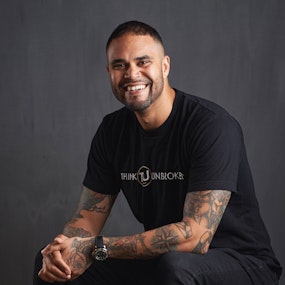
Michael Unbroken
Coach
Michael is an entrepreneur, best-selling author, speaker, coach, and advocate for adult survivors of childhood trauma.

Lindsay Mitchell
CEO/ PA-C
Lindsay Mitchell is a super passionate human, lover of all things neuroscience, and the founder of Vital-Side. She works with people with chronic illness & chronic symptoms retrain the chronic stress response in the brain, so they can find freedom in their lives. Her training in medicine, work as an NLP practitioner, and experience with having recovered from Lyme disease helps her give people the tools they need to shift & change their symptoms in an empowering way. You can find free tips & tools on Instagram @myvitalside or join her Membership today at www.vital-side.com.
Welcome to The Think Unbroken Podcast!
Here are some of my favorite recent guests!



























